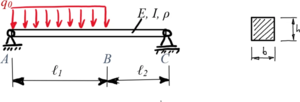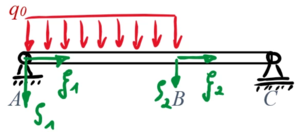Gelöste Aufgaben/Kit4
Aufgabenstellung

Gesucht ist für den Euler-Bernoulli-Balken die dimensionslose Form der Bewegungs-Differentialgleichung.
Die dimensionsbehaftete Form der Bewegungsgleichung lautet
Um die dimensionslose Form der Bewegungsgleichung zu bekommen, ersetzten wir
- .
Dimensionsbehaftet ist jetzt noch w(x) und seine Ableitungen. Mit der Koordinaten-Transformation
erhalten wir
- .
Einsetzen liefert
Die Bezugsgrößen dürfen wir frei wählen - aber wie? Für ℓBez = h drücken wir die Auslenkung w als Vielfaches von h aus - das ist praktisch! Denn damit die Annahmen zur Linearisierung beim Euler-Bernoulli-Balken eingehalten werden, sollte w ≤ h, also
Für die Bezugskaft bietet sich FBez = G an, wobei G die Gewichtskraft des Balkens ist. Dann ist das Vielfache der Gewichts-Streckenlast.
Umschreiben und Auflösen liefert mit I = h4/12
oder abgekürzt:
Die dimensionslose Ortskoordinate brauchen wir für den Rest der Aufgaben - man wählt deshalb oft
und erhält als neue Bewegungsgleichung
So ist die analytische Lösung der Bewegungsgleichung für den Bereich i:
wobei der Bereich i=1 zwischen A-B sowie i=2 zwischen B-C liegt.
Die Rand- und Übergangsbedingungen lauten dann mit ℓ2 = ℓ1/2
- , , .
Lösung mit Maxima
Lorem Ipsum ....
tmp
Title
Text
1+1
Links
- ...
Literature
- ...
[[|mini|Lageplan]]
